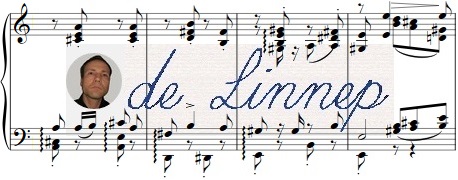
The Editor proposes to transform this fugue, by doubling the soprano in the higher octave and the bass in the lower octave, into a Study in Octaves, the usefulness of wich, on account of the peculiar structure of the figuration, should be very great.
Though the rôle of octave-technique in modern piano-playing is a very prominent one, and in spite of the many extant methods and examples, but little has been taught or written concerning the manner in which octaves ought to be played. At this juncture, therefore, the Editor considers it appropriate to offer a few remarks on the most important points. These are:
The position of the hand. The back of the hand, together with the first joints of the fingers, should form an even, nearly horizontal plane, having a slight downward inclination from the wrist. The three middle fingers, which are mostly unemployed, should be held in a loose group, with their tips drawn inward, so that the disagreeable scuffling across the intervening keys in the octave may be avoided. While the wrist should move with perfect freedom and looseness, care must be taken to keep the thumb and little finger at exactly the right distance apart, and in position for striking.
The movements, of which there are three:
a) The striking of the key, – a sharp, decided downward movement of the wrist. On this the Editor wishes to lay special stress; while the rebound of the hand from the keyboard should be involuntary, effected solely by the combined elasticity of the hand and the pianoforte-action. (Though the above applies chiefly to detached octave-playing, the characteristic element of octave-technique, the principle therein contained is equally applicable to the subspecies of the Portamento, legato octave-playing.)
b) The second kind of movement is that of the arm. It is the function of the latter to follow the hand sideways and horizontally, and to carry it over the place where the down-stroke is to be made. This renders it possible to strike the keys vertically and exactly in the middle. The movement of the arm, which principally affects the forearm, must likewise be perfectly free and loose.
c) The third kind of movement is the turning of the wrist, carrying the hand with it, to either side, the arm remaining quiet; also, the slight shifting from white to black keys, and vice versa.
The former occurs when the distance between the keys to struck is too small to require a shifting in the position of the arm, for instance in appoggiaturas, trills, or in figures revolving about a central tone, e.g.

Position of hand, on central tone d. on central tone g .
In passing from white keys to the black keys lying further back, the point where the key is struck should be so shifted as to carry the hand gradually from the edge of the keyboard to the middle. For example, the way which the hand would take in playing the octaves:
| might be represented as follows: | 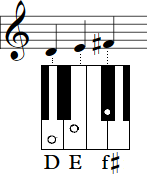 |
In such cases another rule is to be observed, namely, that the wrist is to remain at the same height for striking both the white and the black keys, consequently, the fall of the hand is less for the latter than for the former.
Above all, however, the player must seek to aquire an equal and even stroke both in tone and rhythm, and an equal power of tone in both notes of the octave.
Finally, one of the most important points in learning octave-playing is
The Phrasing, * i.e., the grouping of the tones of a passage in conformity (a) with the musical motives, (b) with the position of the notes on the keyboard, or (c) with the change in the direction, This grouping, however, should be audible only to the player, and in public performances should properly form only a mental, not a physical, factor.
* To the best of my knowledge, this valuable expedient – which, besides, is entirely independent of the musical phrasing – has not as yet been theoretically exploited.
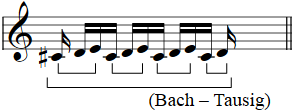
Taken thus, each group requires only a simple sideways movement (up) and the easy successive seconds are retained.

The phrasing: on the contary, would require a twofold shifting of the hand, and exhibit an ascending second followed by a descending leap of a third.

In the following passage: the upper phrase-marks show leaps of fourths and fifths, while those below give successive seconds.
The example quoted above, from Chopin's Nocturne, is to be phrased in such a way that the hand remains, in each group, quietly over the same tone:

| whereas the following passage: | 
|
can be best executed, as marked above, by letting the hand glide easily between the 1st and 2nd tones of each group, from the black key, to the white one.
Further examples in phrasing (all to be imagined in octaves) are:






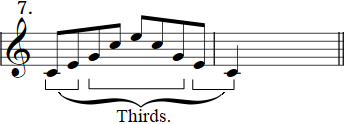





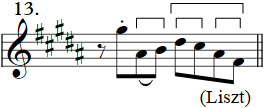

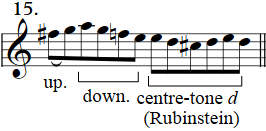

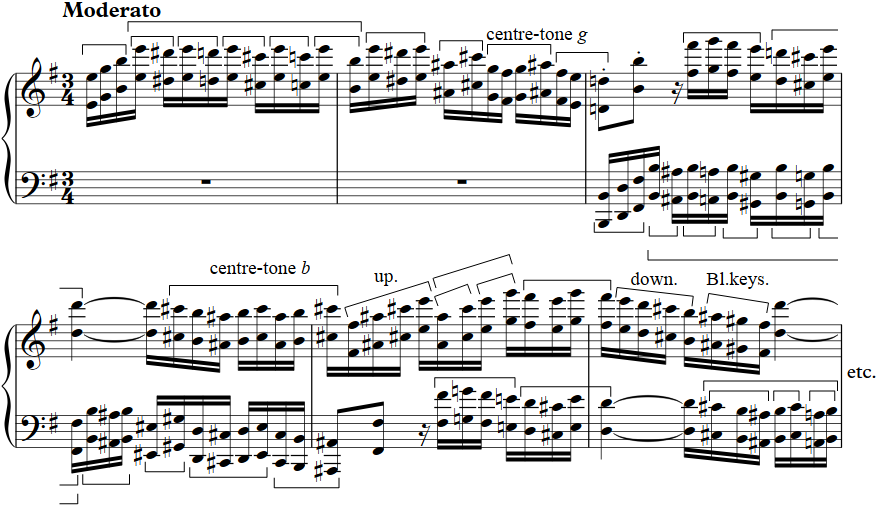
Even should the player not avail himself, in the present case, of this critique of octave-playing, it will prove extremely useful in executing Bach's organ-pieces on the piano.
Site map Copyright © 2014 Inno de Linnep webmaster@delinnep.com